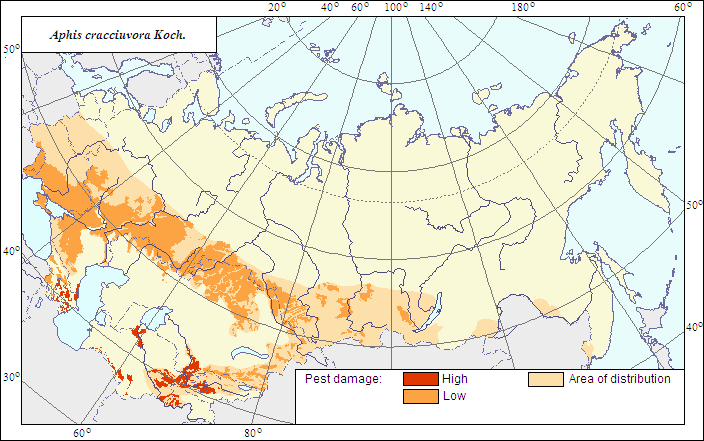Pests
The area and damage zones of Aphis craccivora Koch.
 Object description Download GIS-layers
Object description Download GIS-layers
Authors:
Specialist-biologist M.N. Berim,GIS-specialist M.I. Saulich.
Date of creation:
08.05.2007.Scale:
1:20 000 000.Accuracy of map:
It is created on materials of map of natural scale 1:33 000 000.Projection:
"Alber's Equal Area Conic", 9, 1001, 7, 100, 0, 44, 68, 0, 0.Basic contents:
Vector map is composed of 3 thematic layers. Zones of distribution and damage are shown by polygons.Accuracy of the classifier:
The insect area is divided into zones of high and low damage using the published materials (Rekach, 1933, 1938; Alimdzhanov, Zhuravleva, 1963; Shomirsaidov, 1983). The zone of high damage includes regions that are characterized by periodical damage to cotton plants according to points 3 and above (20 individuals on 1 bush at 50% populating bushes); the zone of low damage is characterized according to points 1 and 2 (8-10 individuals on 1 bush, when it has 2-3 real leaves at 25% populated bushes) (Drakhovskaya, 1962).Method of map production:
The northern border has been marked after the published materials (Rekach, Dobretsova1933; Shaposhnikov, 1964; Ivanovskaya, 1976). The species is marked in West Siberia (big number) (Ivanovskaya, 1976), also in Primorskii Territory (Ivanovskaya, Kupyanskaya, 1979). High mountains and deserts are excluded from the area. The borders of zones of different harmfulness are given, using criteria that have been published by V.N. Rekach, T.A. Dobretsova (1933); A.A. Mamedova (1957); R.A. Alimdzhanov I.A. & Zhuravleva (1963); Sh. Shomirsaidov (1983). The zone of low pest damage includes all main regions of alfalfa growing, except Baltic States. High harmful activity is observed within main cotton regions; i.e., Middle Asia, South Kazakhstan, Azerbaijan. The vector map of distribution of cotton and alfalfa within the territory of the Former Soviet Union has also been used for the correction of damage zones (Koroleva et al., 2003).Reference citations:
Alimdzhanov R.A., Zhuravleva I.A. 1963. On harming activity of groundnut aphid Aphis craccivora Koch. In: Arifov U.A., ed. Proceedings of AN Uzb. SSR. N 11. Tashkent: AN Uz. SSR. 50-53 p. (in Russian).Baranov A.N. 1969. Atlas of the USSR. Moscow: Chief Department of Geodesy and Cartography. 90-91 p. (in Russian).
Belikova E.V. 1983. Biological connections of groundnut aphid on cotton field and its regulation ways. In: Livshits M.F., ed. Integrated cotton protection in Turkmenistan. Ashkhabad: Ylym. 74-81 p. (in Russian).
Bozhko M.P. 1976. Aphids of food plants. Khar'kov: Vishcha shkola. 134 p. (in Russian).
Drakhovskaya M. 1962. Forecasting in plant protection. Moscow: Publishing House of Agricultural literature, magazines and posters. 165 p.(in Russian).
Ivanovskaya O.I. 1976. Fauna of aphids on the territory of West Siberia. In: Zolotorenko G.S., ed. Fauna of helminthes and arthropods of Siberia. Novosibirsk: Nauka. P. 175-189.
Ivanovskaya, O.I., Krupyanskaya, A.N. 1979. The aphids (Homoptera, Aphididae) damaging trees and bushes in Primorskii Territory. In: Ivliev L.A., ed.. Ecology and biology of arthropods in the southern Far East. Vladivostok: AN SSSR. 36-53 p. (in Russian).
Karavyanskii N.S., Mazur O.P. 1975. Pests and diseases of fodder cultures. Moscow: Rossel'khozizdat. p. 34-35 (in Russian).
Kesten L.A. 1975. Entomophagous of groundnut aphid. Zashchita rastenii 11: 28 (in Russian).
Koroleva I.E., Vil'chevskaya E,V., Rukhovich D.I. 2003. Vector maps of maximal distribution of arable lands. www agroatlas. spb. ru.
Kosov V.V., Polyakov I.Ya., ed. 1958. Forecasting and calculation of pests and diseases on agricultural cultures. Moscow: Agricultural Department. 342 p. (in Russian).
Mamedova A.A. 1957. Materials to studying of cotton aphids in Azerbaijan. In: Aliev M.M., ed. Proceedings of AN Azer. SSR. N 6. Baku: AN Azer. SSR. 118-120 p. (in Russian).
Migulin A.A. 1983, ed. Agricultural entomology. Moscow: Kolos. 162-163 p. (in Russian).
Narzikulov M.N., Shomirsaidov Sh. 1975. News about amphigonic generation of groundnut .Aphis craccivora Koch. (Homopt. Aphididae) in Tajikistan. In: Narziculov M.N., ed. Proceedings of AN Tajik. SSR. Dushanbe: AN Tajik. SSR. 46-51 p. (in Russian).
Nevskii V.P. 1929. Aphids of Middle Asia. Proceedings of Uzbekistan Experimental plant protection station 16. Tashkent. 181-186 p. (in Russian).
Polyakov I.Ya., ed. 1989. Forecasting of pests and diseases on agricultural cultures for 1989. Moscow VIZR. 145-146 p. (in Russian).
Rekach V.N. 1938. Aphids on cotton in southern regions of European part of Russia. Pyatigorsk: kraivedizdat. 87 p. (in Russian).
Rekach V.N. 1939. On overwintering of groundnut aphid. Sovetskii khlopok 1: 69-70 (in Russian).
Rekach V.N., Dobretsova T.A. 1933. Aphids of cotton in Transcaucasia. Materials on its biology and control. Tiflis: Tekhnika da Shroma. 107 p. (in Russian).
Shaposhnikov G.Kh. 1964. Suborder Aphidinea . aphids. In: Bei-Bienko G.Ya., ed. Keys to insects of the European part of the USSR. V. 1. Moscow & Leningrad: Nauka. 572 p. (in Russian).
Shomirsaidov Sh. 1977. Groundnut aphid as dangerous component of cotton-alfalfa agrobiocenosis and integrated control against it in South Tajikistan. PhD Thesis. Baku: Zoological institute of AN Azerb. SSR, 26 p. (in Russian).
Shomirsaidov Sh. 1983. Groundnut aphid as dangerous component of cotton-alfalfa agrobiocenosis and integrated control against it in Tajikistan. Dushanbe: Donish. 104 p. (in Russian).
Uspenskii F.M. 1951. Significance of white acacia and others Fabaceae at cotton infestation by groundnut aphid. In: Mirpulatov K.I., ed. Pests and diseases of cotton and others cultures and control measures (Proc. of Uz. STAZR). Tashkent: Soyuz NIKhI. 39-43 p. (in Russian).
Uspenskii F.M., Solov'eva A.I. 1956. Pests and diseases of cotton. Cottongrowing. Tashkent: gosizdat Uz.SSR. p. 270 (in Russian).
Vasil.ev V.P., ed. 1973. Pests of agricultural crops and forest plantations. 1. Kiev: Urozhai. .285-287 p. (in Russian).

